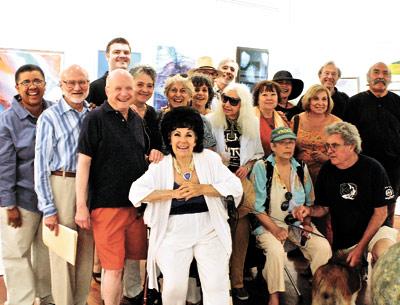Opinion: Artists Alliance at Ashawagh Hall

If the East End teems with hidden artistic talent, then the annual studio tour sponsored by the Artists Alliance of East Hampton is one of the summer’s singular pleasures of discovery. In the era of slow food and organic harvest, it feels spot-on to find a studio at the end of a country road, discuss art with the artist, and perhaps leave with that gem for your empty wall space.
Last weekend’s tour showcased some 22 artists, largely in East Hampton though there were a smattering of studios in Bridgehampton, Sag Harbor, and Water Mill. If you missed the tour, however, it would be worth your while to drop by Ashawagh Hall in Springs, where the annual alliance members exhibition will be on view through Sunday. Paintings, drawings, sculpture, mixed-media works, and photographs by some 100 artists, including virtually all the participants in the studio tour, are on view, in most cases a single piece that is representative of their work at large.
A little context here. The artists alliance was started in 1984 as a tribute to the late Jimmy Ernst, the son of Max Ernst and himself an internationally renowned artist. (In the early days it was called the Jimmy Ernst Artists Alliance.) Impromptu meetings gave way to full nonprofit status in the 1990s, with bylaws stating that its exhibitions, open to all members, would not be juried. This egalitarian spirit produces shows that are sometimes a riotous mixture of high and low, which is exactly what makes them so much fun.
That being said, this year’s member show has several abstracts that display greater passion for color and chaos than they do a deft painterly hand or a particular vision. A few stand out for their unassuming accomplishment. Among them are Maryam Javaheri’s untitled composition in mixed media and Katherine Hammond’s “Attitude.” In spare rectangular shapes, Ms. Hammond’s work on paper explicitly suggests a bird on a piling, with deft childlike simplicity.
As is always the case, still lifes, seascapes, and landscapes form the backbone of the show. In her oil “Sag Harbor Cinema,” Barbara Hadden puts you smack on the sidewalk of Main Street. Frank Sofo’s acrylic “Summer Treats” might be a concession stand at a beach on the East End or anywhere in the Northeast, where hordes of vacationing parents and children line up for their requisite hot dogs and ice cream. With his fluffy lavender cumulus clouds, applied in quick, sure strokes, Mr. Sofo captures a summer spirit of freedom and restlessness.
In contrast, Casey Chalem Anderson’s “Three-paneled Atlantic Wave” serves up a summer as pristine and fresh as sea foam. This oil represents the East End as we like to think of it, unspoiled and serenely uncomplicated. Flanking Ms. Anderson’s painting are Deborah Palmer’s haunting “September Sunset” and Hannah A. Kinn’s “Mist.” In these evocative oil paintings of inlet views, you can almost feel the chill of changing seasons and atmosphere.
Not to be outdone, two off-center architectural landscapes, both photographs, give the show its edge. Intriguingly, they leave unanswered questions dangling in space. Sharmila Sen’s wonderful “Swan at Broad Channel” is a snapshot view of a neglected patch of yard behind a shingled white house on an industrial waterway — with a concrete Madonna, a yellow ribbon tied around a flagpole, and, incongruously, a swan extending its wings center stage. Is the swan a pet or a transient?
In “Milltown C.,” Carolyn Conrad assembles man-made objects into a misty panorama that could be a series of toy barns at dawn. Yet, these mysterious structures might also house something alien, illegal, or even tantalizingly dangerous.
Still life is the haven of the novice and also the measure of experience. Painterly renderings are no less glorious for harking back to another era, as Pam Vossen’s “Soup’s On,” driven by a 17th-century Dutch sensibility, and Marsha Tucker’s modernist “Eggs and Persimmon” prove. Still life is home. Almost everyone can relate, and it is a pleasure to be diverted by interpretations of what we know.
Additional highlights worthy of mention include two nudes, each a skewed take on a classical style. Without a specified medium, it’s hard to know how Phil Marco came by “Dionne,” who seems to have been purloined from an 18th-century work, submerged in water, and photographed. She holds up rather beautifully in spite of it all. Anne Brandeis’s aptly named “In Limbo” is superimposed photographic layers with an actual nude lying facedown in the woods — cryptic, a little dire, but interesting still.
Of the handful of sculptures, Phyllis Hammond’s abstract “Dancing” stands out. It has the feel of a study; it might be even more eloquent if it were magnified. “Hecate,” by Sarah Jaffe Turnbull, interprets a bust of the ancient Greek goddess of the moon into a talisman that is the size and shape of a bowling ball.
It’s hard to know what to make of the gallery in the rear of Ashawagh Hall, which is reserved in part for several impenetrable collages, or works that look as though they might double as children’s games. A single wooden stick in the corner, painted white, opens a whimsical dialogue. The piece by Barbara Malmet bears an inscription from Colson Whitehead’s novel “Sag Harbor”: “There was summer and then there was everything else.” Right on.
